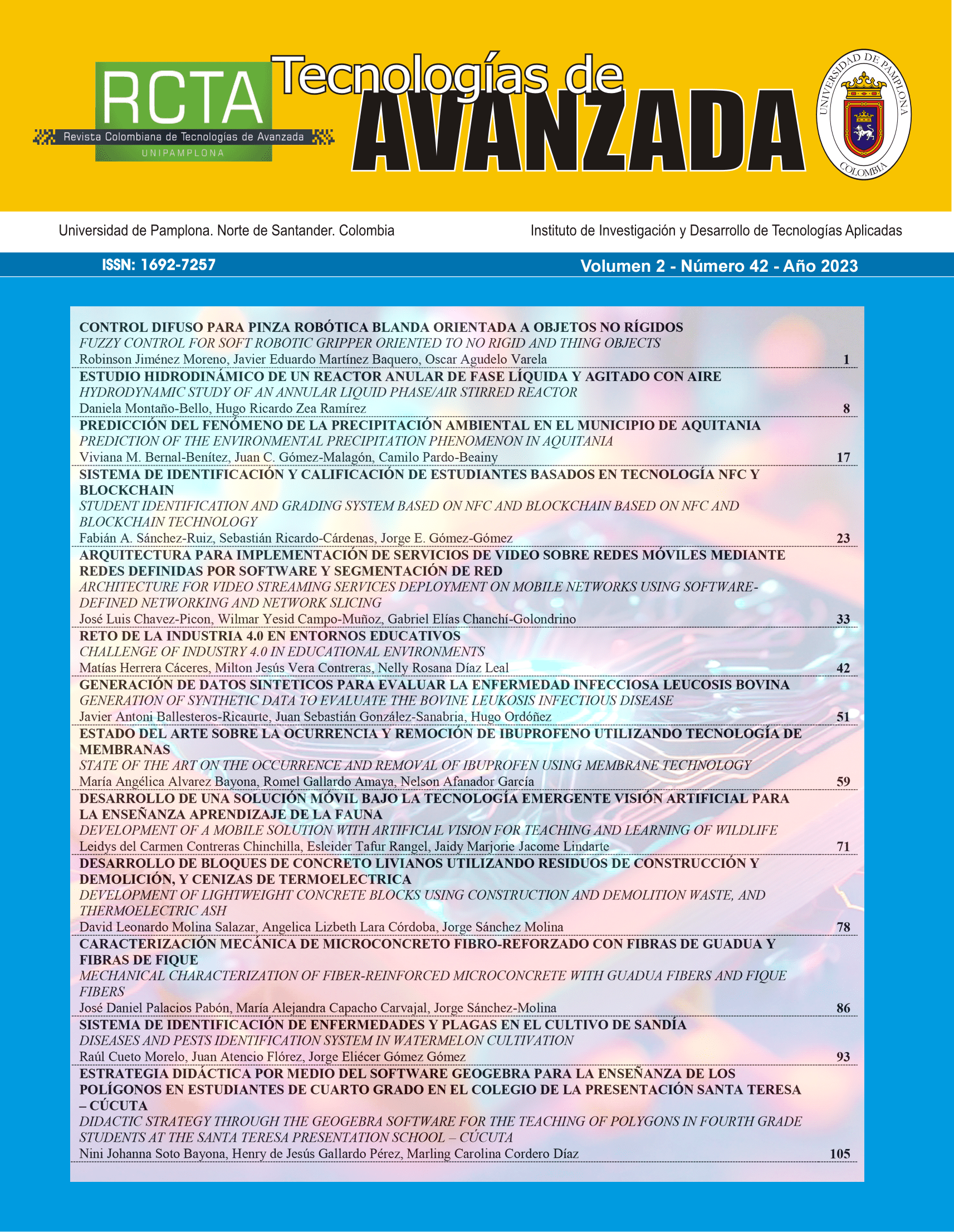Control difuso para pinza robótica blanda orientada a objetos no rígidos
DOI:
https://doi.org/10.24054/rcta.v2i42.2647Palabras clave:
Agarre bio-inspirado, Control difuso, Impresión 3D, Robótica suaveResumen
El presente artículo expone el diseño de un efector robótico construido con sensórica interna en material flexible. Basados en el agarre bioinspirado de objetos delgados típicamente no rígidos realizados con dos dedos por os humanos, se establecen las características del modelo 3 que sirve de base para la impresión de este, incluyendo espacio interno para una flexoresistencia que permita identificar el porcentaje de flexión para agarre, mediante el efector. Se diseña un controlador difuso para control del efector y dada la tolerancia del sensor se emplea un sistema de inferencia difusa Mamdani tipo-2. Los resultados muestran un agarre adecuado que permite obtener un error de estado estacionario cercano a cero, permitiendo agarrar objetos delgados como un pañuelo o una pieza de papel higiénico.
Descargas
Citas
Amin, Y., Gianoglio, C., & Valle, M. (2023). Embedded real-time objects’ hardness classification for robotic grippers. Future Generation Computer Systems, 148, 211–224. https://doi.org/10.1016/j.future.2023.06.002
An, T., Zhu, X., Zhu, M., Ma, B., & Dong, B. (2023). Fuzzy logic nonzero-sum game-based distributed approximated optimal control of modular robot manipulators with human-robot collaboration. Neurocomputing, 543, 126276. https://doi.org/https://doi.org/10.1016/j.neucom.2023.126276
Bi, Z., Liu, Y., Krider, J., Buckland, J., Whiteman, A., Beachy, D., & Smith, J. (2018). Real-time force monitoring of smart grippers for Internet of Things (IoT) applications. Journal of Industrial Information Integration, 11, 19–28. https://doi.org/10.1016/j.jii.2018.02.004
Chen, K., Lou, V. W., & Cheng, C. Y. M. (2023). Intention to use robotic exoskeletons by older people: A fuzzy-set qualitative comparative analysis approach. Computers in Human Behavior, 141, 107610. https://doi.org/https://doi.org/10.1016/j.chb.2022.107610
Dinakaran, V. P., Balasubramaniyan, M. P., Le, Q. H., Alrubaie, A. J., Al-khaykan, A., Muthusamy, S., Panchal, H., Jaber, M. M., Dixit, A. K., & Prakash, C. (2023). A novel multi objective constraints based industrial gripper design with optimized stiffness for object grasping. Robotics and Autonomous Systems, 160, 104303. https://doi.org/https://doi.org/10.1016/j.robot.2022.104303
Dinakaran, V. P., Balasubramaniyan, M. P., Muthusamy, S., & Panchal, H. (2023). Performa of SCARA based intelligent 3 axis robotic soft gripper for enhanced material handling. Advances in Engineering Software, 176, 103366. https://doi.org/https://doi.org/10.1016/j.advengsoft.2022.103366
Fox, S., & Griffy-Brown, C. (2023). Robotics in society: Technology in Society Briefing. Technology in Society, 72(October 2022), 102174. https://doi.org/10.1016/j.techsoc.2022.102174
Goh, G. L., Yeong, W. Y., Altherr, J., Tan, J., & Campolo, D. (2022). 3D printing of soft sensors for soft gripper applications. Materials Today: Proceedings, 70, 224–229. https://doi.org/https://doi.org/10.1016/j.matpr.2022.09.025
Gu, T., Bi, H., Sun, H., Tang, J., Ren, Z., Zhou, X., & Xu, M. (2023). Design and development of 4D-printed cellulose nanofibers reinforced shape memory polymer composites: Application for self-deforming plant bionic soft grippers. Additive Manufacturing, 70, 103544. https://doi.org/https://doi.org/10.1016/j.addma.2023.103544
Han, J., Shan, X., Liu, H., Xiao, J., & Huang, T. (2023). Fuzzy gain scheduling PID control of a hybrid robot based on dynamic characteristics. Mechanism and Machine Theory, 184, 105283. https://doi.org/https://doi.org/10.1016/j.mechmachtheory.2023.105283
Jorg, O., & Fantoni, G. (2023). A self-adaptive high precision gripper for shape variant components: Towards higher reliability and efficiency of a cobotic cell. Journal of Manufacturing Systems, 70, 113–126. https://doi.org/https://doi.org/10.1016/j.jmsy.2023.04.003
Kumar, A., Raj, R., Kumar, A., & Verma, B. (2023). Design of a novel mixed interval type-2 fuzzy logic controller for 2-DOF robot manipulator with payload. Engineering Applications of Artificial Intelligence, 123, 106329. https://doi.org/https://doi.org/10.1016/j.engappai.2023.106329
Lee, K., & Cha, Y. (2023). Quasi-static analysis of an electrohydraulic actuator for a soft gripper. Sensors and Actuators A: Physical, 352, 114214. https://doi.org/https://doi.org/10.1016/j.sna.2023.114214
Ma, B., Zhang, Y., Li, J., Chen, D., Liang, R., Fu, S., & Li, D. (2023). 4D printing of multi-stimuli responsive rigid smart composite materials with self-healing ability. Chemical Engineering Journal, 466, 143420. https://doi.org/https://doi.org/10.1016/j.cej.2023.143420
Mehrjouyan, A., Menhaj, M. B., & Hooshiar, A. (2023). Safety-enhanced observer-based adaptive fuzzy synchronization control framework for teleoperation systems. European Journal of Control, 73, 100885. https://doi.org/https://doi.org/10.1016/j.ejcon.2023.100885
Park, H. I., Cho, T. J., Choi, I.-G., Rhee, M. S., & Cha, Y. (2023). Object classification system using temperature variation of smart finger device via machine learning. Sensors and Actuators A: Physical, 356, 114338. https://doi.org/https://doi.org/10.1016/j.sna.2023.114338
Ren, J., Wu, F., Shang, E., Li, D., & Liu, Y. (2023). 3D printed smart elastomeric foam with force sensing and its integration with robotic gripper. Sensors and Actuators A: Physical, 349, 113998. https://doi.org/https://doi.org/10.1016/j.sna.2022.113998
Sarkar, A., Maji, K., Chaudhuri, S., Saha, R., Mookherjee, S., & Sanyal, D. (2023). Actuation of an electrohydraulic manipulator with a novel feedforward compensation scheme and PID feedback in servo-proportional valves. Control Engineering Practice, 135, 105490. https://doi.org/https://doi.org/10.1016/j.conengprac.2023.105490
Wang, W., Tang, Y., & Li, C. (2021). International Journal of Mechanical Sciences. International Journal of Mechanical Sciences, 193, 196182. https://doi.org/10.1016/j.ijmecsci.2020.106181
Xu, D., Huang, J., Su, X., & Shi, P. (2019). Adaptive command-filtered fuzzy backstepping control for linear induction motor with unknown end effect. Information Sciences, 477, 118–131. https://doi.org/https://doi.org/10.1016/j.ins.2018.10.032
Yeong, W. Y., Goh, G. L., Goh, G. D., Lee, S., Altherr, J., Tan, J., & Campolo, D. (2022). 3D printing of soft grippers with multimaterial design: Towards shape conformance and tunable rigidity. Materials Today: Proceedings, 70, 525–530. https://doi.org/https://doi.org/10.1016/j.matpr.2022.09.552
Zhang, Y., Liu, T., Lan, X., Liu, Y., Leng, J., & Liu, L. (2022). A compliant robotic grip structure based on shape memory polymer composite. Composites Communications, 36, 101383. https://doi.org/https://doi.org/10.1016/j.coco.2022.101383
Zhang, Z., & Niu, Y. (2023). Probabilistic-constrained control of interval type-2 T–S fuzzy systems under the multi-node round-robin scheduling protocol. Journal of the Franklin Institute, 360(9), 6566–6584. https://doi.org/https://doi.org/10.1016/j.jfranklin.2023.04.033
Zhao, C., Yang, X., Yu, J., Yang, M., Wang, J., & Chen, S. (2023). Interval type-2 fuzzy logic control for a space nuclear reactor core power system. Energy, 280, 128102. https://doi.org/https://doi.org/10.1016/j.energy.2023.128102
Zheng, K., Zhang, Q., Peng, L., & Zeng, S. (2023). Adaptive memetic differential evolution-back propagation-fuzzy neural network algorithm for robot control. Information Sciences, 637, 118940. https://doi.org/https://doi.org/10.1016/j.ins.2023.118940
Descargas
Publicado
Cómo citar
Número
Sección
Licencia
Derechos de autor 2023 Robinson Jiménez Moreno, Javier Eduardo Martínez Baquero, Oscar Agudelo Varela

Esta obra está bajo una licencia internacional Creative Commons Atribución-NoComercial 4.0.















